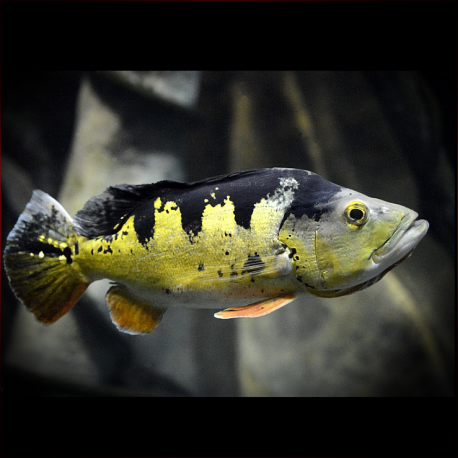More info
Datasheet
| Minimum Tank Size | 1000 litres / 264.17 US gallons |
| Maximum Size | 75.0cm / 29.53inches |
| Temperature | 24°C / 75.20°F - 27°C / 80.60°F |
| Hardness | 0-15ºdH |
| pH | 6.5-7.0 |
General Description
The Peacock Bass (Cichla Ocellaris) is a species of cichlid known for its large size, reaching up to 75.0cm in length. They are native to northern South America but have been introduced to other regions like Singapore and the USA. This species is popular among experienced fishkeepers due to its hardy nature and adaptability to various conditions.
Aquarium Setup
To house Peacock Bass successfully, a tank with a minimum size of 1000 litres is necessary. They require ample swimming space and a tank setup with large pieces of bogwood and robust plants, although the tank should be furnished sparsely. Efficient filtration, preferably external or sump filtration, is crucial due to their large size and messy nature. Water conditions should ideally maintain a pH of 6.5-7.0, hardness of 0-15 dH, and a temperature range of 24-27°C.
Behaviour
Peacock Bass are known to be territorial and moderately aggressive. They can be kept in species groups or with other large fish such as arowana, stingrays, large catfish, and other large cichlids. However, due to their predatory nature, they may consume tankmates that are small enough to be considered as food.
Feeding and Diet
Being piscivorous, the diet of Peacock Bass should consist mainly of meaty foods like prawn, mussel, lancefish, whitebait, and other white fish. Providing a varied diet rich in protein is essential for their health and vitality.
Reproduction & Dimorphism
Limited reports exist on breeding Peacock Bass in captivity. Sexual dimorphism is evident in this species, with males growing larger than females and developing a nuchal hump as they mature.
Habitat and Distribution
In the wild, Peacock Bass inhabit regions of Colombia, Venezuela, Guyana, Suriname, French Guiana, and Brazil. They have also been introduced to countries like Singapore and the USA, where they have established populations. Maintaining water conditions that mimic their natural habitat is crucial for their overall well-being and longevity.

